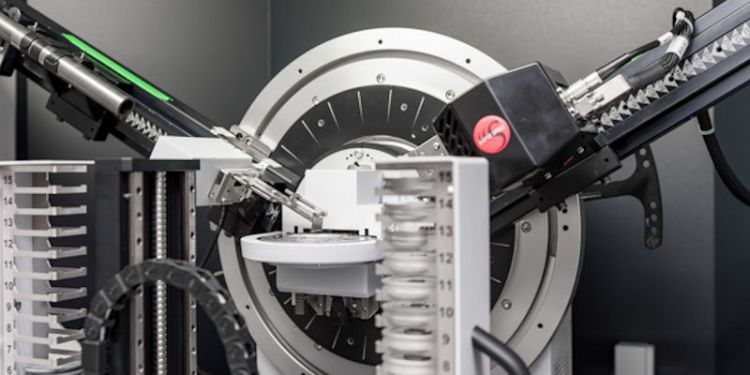X-ray Diffraction and X-ray Fluorescence (XRD/XRF)
- Overview: Our XRD and XRF facilities include a preparation laboratory and an instrument laboratory. Analysis is available on a Bruker D8 XRD, a Philips XRD and a portable XRF.
- Contact name: Lesley Neve (Technical Lead)
- Phone: +44 (0)113 343 5226
- Email: l.a.neve@leeds.ac.uk

Equipment
The department has a Bruker XRD and a Philips XRD providing powder diffraction analysis.
There is an International Centre for Diffraction Data (ICDD) database for indexing patterns using specialised software package EVA® which identifies what components are present as well as access to the Topas® software which is a modelling programme to identify what quantities are present.
External users can access this software for data processing.
The Bruker D8 uses a Cu Kα source and is equipped with a LynxEye detector and a 90 position auto sampler. These provide advantages in terms of intensity, peak-to-background ratio and accurate profile fitting.
- It is configured in vertical theta/2theta Bragg-Brentano (a common design widely used for powder diffractometers) and has a scanning range of 2-150°
- The instrument can run samples on either reflection or capillary stages
Measurement capabilities are:
- Qualitative phase analysis
- Quantitative phase analysis
- Structure solution and refinement
- Crystallite size determination
The Philips PW1050 uses a Cu Kα source and is fitted with a secondary graphite monochromator (an optical device used to select radiation of a single wavelength)
- The Philips has a scanning range of 3-105°
Measurement capabilities are:
- Qualitative phase analysis
- Quantitative clay analysis using the RIR (relative internal ratio) method
The Olympus Innovex X-5000 portable XRF is available for fieldwork and
- has a Rh source
- capable of analysing powder or solid samples
- fast analysis times – e.g. 3 minutes.
Who can use the facility?
We are committed to sharing our facilities and associated expertise with external academic and industrial collaborators.
Location
School of Earth and Environment. Part of the Bragg Centre for Materials Research.
Members of staff
Academic Lead: Dr Thomas Mueller
Technical Lead: Lesley Neve

